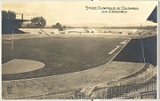
1924 Summer Olympics
Overview
Multi-sport event
A multi-sport event is an organized sporting event, often held over multiple days, featuring competition in many different sports between organized teams of athletes from nation-states. The first major, modern, multi-sport event of international significance was the modern Olympic Games.Many...
which was celebrated in 1924 in Paris
Paris
Paris is the capital and largest city in France, situated on the river Seine, in northern France, at the heart of the Île-de-France region...
, France
France
The French Republic , The French Republic , The French Republic , (commonly known as France , is a unitary semi-presidential republic in Western Europe with several overseas territories and islands located on other continents and in the Indian, Pacific, and Atlantic oceans. Metropolitan France...
. The home city of Pierre de Coubertin
Pierre de Coubertin
Pierre de Frédy, Baron de Coubertin was a French educationalist and historian, founder of the International Olympic Committee, and is considered the father of the modern Olympic Games...
, founder of the modern games, was selected over bids of Amsterdam
Amsterdam
Amsterdam is the largest city and the capital of the Netherlands. The current position of Amsterdam as capital city of the Kingdom of the Netherlands is governed by the constitution of August 24, 1815 and its successors. Amsterdam has a population of 783,364 within city limits, an urban population...
, Los Angeles, Rio de Janeiro, and Rome, though Paris had also hosted the 1900 Games
1900 Summer Olympics
The 1900 Summer Olympics, today officially known as the Games of the II Olympiad, was an international multi-sport event which was celebrated in 1900 in Paris, France. No opening or closing ceremonies were held; competitions began on May 14 and ended on October 28. The Games were held as part of...
.
The cost of the Games of the VIII Olympiad was estimated to be 10,000,000₣
French franc
The franc was a currency of France. Along with the Spanish peseta, it was also a de facto currency used in Andorra . Between 1360 and 1641, it was the name of coins worth 1 livre tournois and it remained in common parlance as a term for this amount of money...
. With total receipts at 5,496,610₣, the Olympics resulted in a hefty loss despite crowds that reached 60,000 people at a time.
- The opening ceremony and several sporting events took place in the Olympic StadiumStade Olympique Yves-du-ManoirThe Stade Olympique Yves-du-Manoir - stadium in Colombes, near Paris, France . Named in memory of French rugby player Yves du Manoir in 1928. Was the main stadium for the 1924 Summer Olympics and had a capacity of 45,000 at the time...
of ColombesColombesColombes is a commune in the northwestern suburbs of Paris, France. It is located from the center of Paris.-History:On 13 March 1896, 17% of the territory of Colombes was detached and became the commune of Bois-Colombes ....
which had a capacity of 45,000 in 1924. - This VIII Olympiad was the last one organised under the presidency of Pierre de CoubertinPierre de CoubertinPierre de Frédy, Baron de Coubertin was a French educationalist and historian, founder of the International Olympic Committee, and is considered the father of the modern Olympic Games...
. - The "Flying FinnsFlying Finn (athlete)"The Flying Finn" is a nickname given to several Finnish athletes. Originally, it was given to several Finnish middle and long-distance runners...
" dominated the long distance running, whilst the British and Americans dominated the shorter events.
Unanswered Questions

